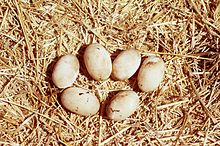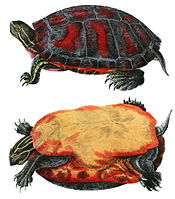- Western pond turtle
-
Western pond turtle 
Actinemys marmorata. Conservation status Scientific classification Kingdom: Animalia Phylum: Chordata Class: Reptilia Order: Testudines Family: Emydidae Genus: Actinemys or Emys[1] Species: A. marmorata Binomial name Actinemys marmorata or Emys marmorata[1]
(Baird and Girard, 1852)Subspecies Actinemys marmorata marmorata
Actinemys marmorata pallidaSynonyms Actinemys nigra
Clemmys marmorata
Clemmys wosnessenskyi
Emys nigra
Geoclemmys nigraThe western pond turtle (Actinemys marmorata or Emys marmorata), or Pacific pond turtle is a small to medium-sized turtle growing to approximately 20 cm (8 in) in carapace length. It is limited to the west coast of the United States of America and Mexico, ranging from western Washington state to northern Baja California. In May 2002, the Canadian Species at Risk Act listed the Pacific pond turtle as being extirpated in Canada.
Contents
Taxonomy
Its genus classification is mixed. Emys and Actinemys were used among published sources in 2010.[3]
Physical description
The dorsal color is usually dark brown or dull olive, with or without darker reticulations or streaking. The plastron is yellowish, sometimes with dark blotches in the centers of the scutes. The shell is 11–21 cm (4.5 to 8.25 in) in length. The dorsal shell (carapace) is low and broad, usually widest behind the middle, and in adults is smooth, lacking a keel or serrations. Adult Western Pond Turtles are sexually dimorphic; that is, males have a light or pale yellow throat and a concave plastron, and the cloacal vent is at or posterior to the edge of the carapace.
Distribution
Western pond turtles originally ranged from northern Baja California, Mexico, north to the Puget Sound region of Washington. As of 2007, they have become rare or absent in the Puget Sound area. They have a disjunct distribution in most of the Northwest, and some isolated populations exist in southern Washington. Pond Turtles are now rare in the Willamette Valley north of Eugene, Oregon, but abundance increases south of that city where temperatures are higher. They may be locally common in some streams, rivers and ponds in southern Oregon. A few records are reported east of the Cascade Mountains, but these may have been based on introduced individuals. They range up to 305 m (1,000 ft) in Washington, and to about 915 m (3.000 ft) in Oregon.
Ecology and behavior
Western pond turtles occur in both permanent and intermittent waters, including marshes, streams, rivers, ponds, and lakes. They favor habitats with large numbers of emergent logs or boulders, where they aggregate to bask. They also bask on top of aquatic vegetation or position themselves just below the surface where water temperatures are elevated. Individuals display aggressive behavior toward one another while sunning. Western pond turtles will rapidly dive off basking sites when approached by humans, even at distances of over 50 m. Consequently, this species is often overlooked in the wild. However, it is possible to observe resident turtles by moving slowly and hiding behind shrubs and trees.
Western pond turtles seek refuge in deep water, under submerged logs and rocks, in beaver burrows and lodges, and by "swimming" into deep silt. They are extremely difficult to detect under these conditions. Turtles can be encouraged to use artificial basking substrate, or rafts, which allows for easy detection of the species in complex habitats.
Diet
Western pond turtles are omnivorous and most of their animal diet includes insects, crayfish and other aquatic invertebrates. Fishes, tadpoles, and frogs are eaten occasionally, and carrion is eaten when available. Plant foods include filamentous algae, lily pods, tule and cattail roots.
Reproduction
Females produce 5-13 eggs per clutch. They deposit eggs either once or twice a year. They may travel some distance from water for egg-laying, moving as much as 0.8 km (1/2 mile) away from and up to 90 m (300 ft) above the nearest source of water, but most nests are with 90 m (300 ft) of water. The female usually leaves the water in the evening and may wander far before selecting a nest site, often in an open area of sand or hardpan that is facing southwards. The nest is flask-shaped with an opening of about 5 cm (2 in). Females spend considerable time covering up the nest with soil and adjacent low vegetation, making it difficult for a person to find unless it has been disturbed by a predator.
Hatchlings
Some hatchings overwinter in the nest, and this phenomenon seems more prevalent in northern areas. Winter rains may be necessary to loosen the hardpan soil where some nests are deposited. It may be that the nest is the safest place for hatchlings to shelter while they await the return of warm weather. Whether it is hatchlings or eggs that overwinter, young first appear in the spring following the year of egg deposition. Individuals grow slowly in the wild, and their age at their first reproduction may be 10 to 12 years in the northern part of the range. Western pond turtles may survive more than 30 years in the wild.
References
- ^ a b Rhodin 2010, p. 000.105
- ^ Tortoise & Freshwater Turtle Specialist Group (1996). Actinemys marmorata. In: IUCN 2008. IUCN Red List of Threatened Species. Downloaded on 23 February 2009.
- ^ Rhodin 2010, p. 000.139
- Species Actinemys marmorata at The Reptile Database
- Bibliography
- Rhodin, Anders G.J.; Paul van Dijk, Peter; Inverson, John B.; Shaffer, H. Bradley (2010-12-14). "Turtles of the World 2010 Update: Annotated Checklist of Taxonomy, Synonymy, Distribution and Conservation Status" (pdf). Archived from the original on 2010-12-15. http://www.webcitation.org/5uzfktoIh. Retrieved 2010-12-15.
Order Testudines (turtles) Suborder SuperfamilySubfamily
Cryptodira Chelydra · MacrochelysCaretta · Chelonia · Eretmochelys · Lepidochelys · NatatorDermochelysDermatemydidaeDermatemysStaurotypinaeClaudius · StaurotypusBatagur · Cuora · Cyclemys · Geoclemys · Geoemyda · Hardella · Heosemys · Leucocephalon · Malayemys · Mauremys · Melanochelys · Morenia · Notochelys · Orlitia · Pangshura · Rhinoclemmys · Sacalia · Siebenrockiella · VijayachelysAldabrachelys · Astrochelys · Chelonoidis · Chersina · Cylindraspis · Geochelone · Gopherus · Homopus · Indotestudo · Kinixys · Malacochersus · Manouria · Psammobates · Pyxis · Stigmochelys · TestudoTrionychiaCarettochelyidaeCarettochelysTrionychinaePleurodira ChelidinaeChelodininaeHydromedusinaePelomedusa · PelusiosPhylogenetic arrangement based on turtles of the world 2010 update: annotated checklist. Extinct turtles not included.
See also List of Testudines families
 Portal ·
Portal ·  WikiProjectCategories:
WikiProjectCategories:- IUCN Red List vulnerable species
- Emys
- Reptiles of North America
Wikimedia Foundation. 2010.



